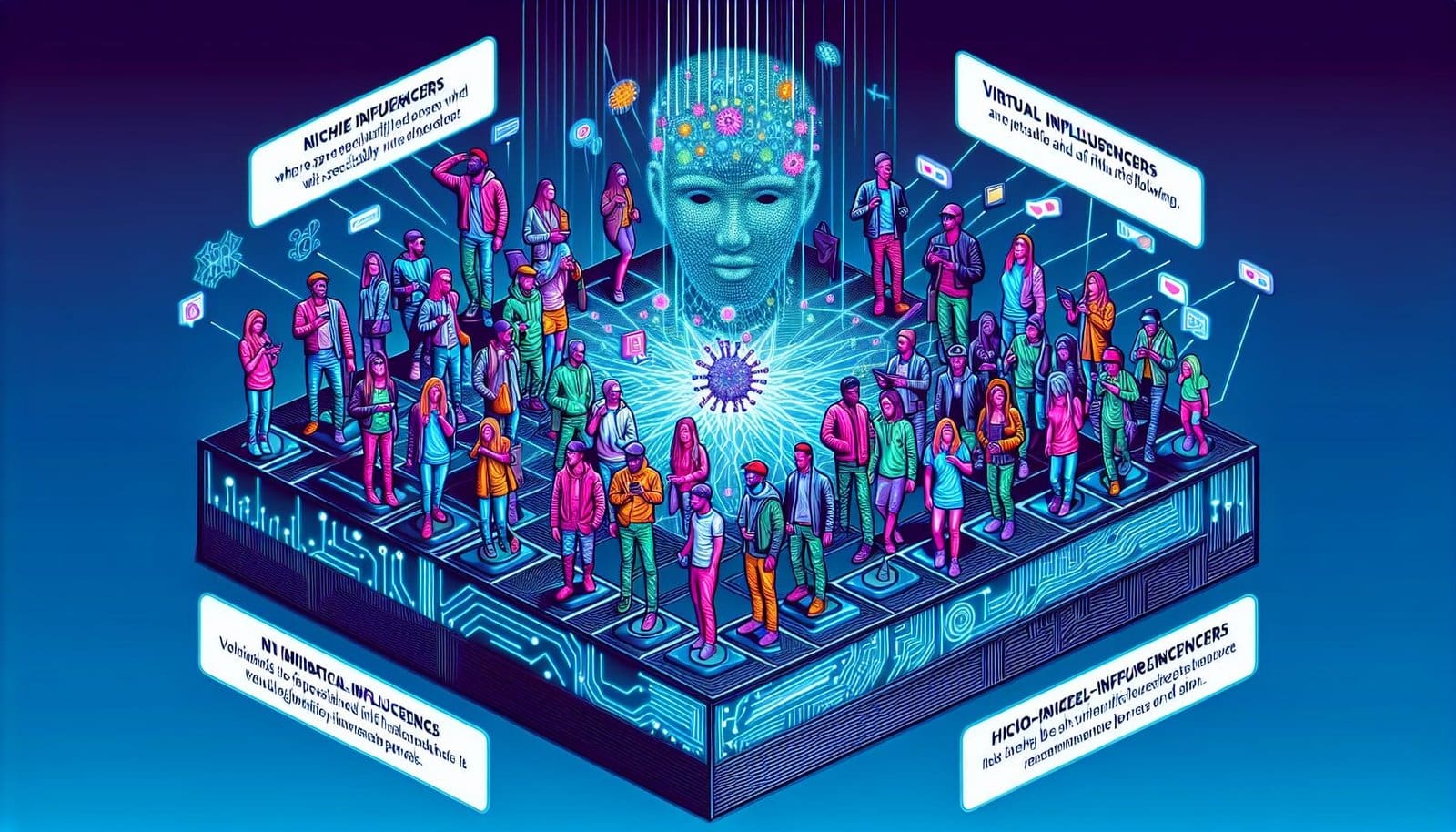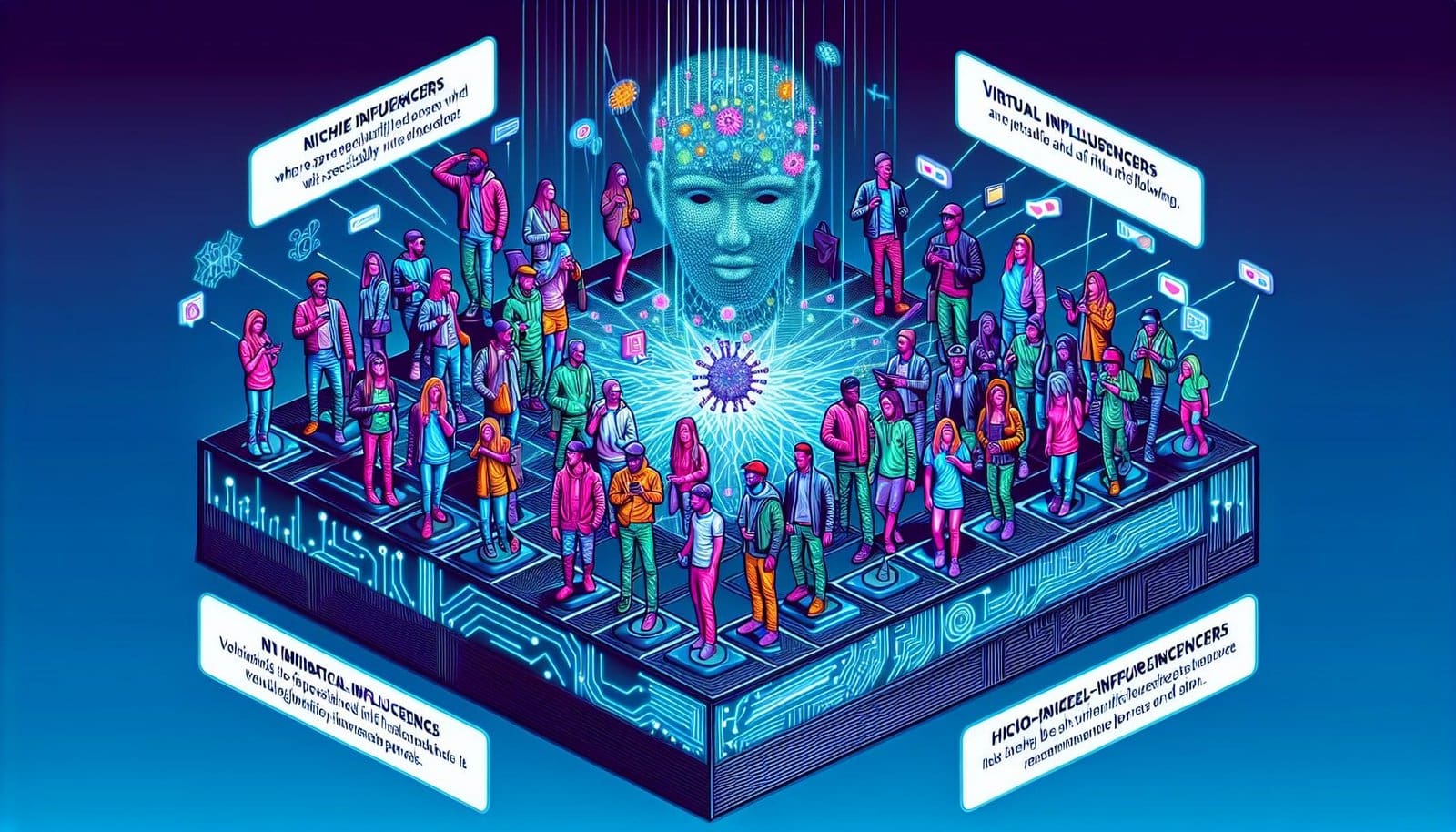In the fast-paced world of social media, where trends come and go like a whirlwind, it is crucial to stay ahead of the game. As 2024 approaches, a new wave of emerging trends in social media influencers is set to shake up the landscape. From digitally enhanced virtual influencers to the rise of niche micro-influencers, the future of social media influence is bright and teeming with exciting possibilities. Get ready to explore these fascinating trends and discover the next big wave in the world of online influence.
The Rise of Micro-Influencers
1.1 Authenticity and Trust
In recent years, social media marketing has witnessed a significant shift towards micro-influencers. These are individuals with a smaller following but a highly engaged and loyal audience. One of the primary reasons for the rise of micro-influencers is their authenticity and trustworthiness. They are seen as relatable and genuine by their followers, which in turn builds trust in the products or services they promote.
Unlike macro-influencers with millions of followers, micro-influencers often have a niche expertise or interest. This allows them to connect with a specific target audience with shared passions and interests. Their content resonates with their audience on a deeper level, leading to higher engagement rates and more meaningful interactions.
1.2 Niche Target Audience
Micro-influencers have the advantage of appealing to a niche target audience. This can be particularly beneficial for brands that cater to specific demographics or interests. By partnering with micro-influencers who have a dedicated following in a particular niche, brands can reach the right audience with a higher chance of conversion.
Additionally, micro-influencers are typically more accessible and approachable compared to their larger counterparts. Their smaller following allows for more personal connections and interactions, allowing them to better understand the needs and preferences of their audience. This deep understanding further enhances their effectiveness in driving brand awareness and engagement.
1.3 Cost-Effective Marketing Strategy
Micro-influencers often offer a cost-effective marketing solution for brands, especially those with limited budgets. Collaborating with micro-influencers tends to be more affordable compared to partnering with macro-influencers or celebrities. While macro-influencers may have a wider reach, the engagement and conversion rates of micro-influencers can compensate for the difference in reach.
Furthermore, working with micro-influencers allows brands to diversify their influencer portfolio. Instead of relying solely on a few high-profile influencers, brands can engage with multiple micro-influencers, tapping into various niches and target audiences. This approach not only maximizes the reach but also offers a more comprehensive and well-rounded influencer marketing strategy.
Video Content Dominance
2.1 Short-form Video Platforms
Video content has experienced a significant surge in popularity across social media platforms in recent years. Short-form video platforms, such as TikTok and Instagram Reels, have become a dominant force in capturing user attention and engagement. These platforms allow users to create and consume bite-sized videos, often featuring creative storytelling, humor, or educational content.
Brands have recognized the potential of short-form video platforms to reach and engage with their target audience. By leveraging the viral nature of these platforms, brands can tap into the vast user base and generate organic reach and brand awareness. The challenge lies in creating content that resonates with the platform's unique style and captivates the users within a short span of time.
2.2 Livestreaming and Real-time Interaction
Another trend in video content consumption is the popularity of livestreaming. Livestreaming platforms like Facebook Live, Instagram Live, and Twitch offer real-time interaction between influencers and their audience. This creates a sense of authenticity and immediacy, fostering a deeper connection between influencers and their followers.
Brands can leverage livestreaming as a powerful marketing tool by collaborating with influencers for product launches, behind-the-scenes glimpses, tutorials, or Q&A sessions. The interactive nature of livestreaming allows for direct engagement, real-time feedback, and the opportunity to showcase products or services in an authentic and compelling way.
2.3 Influencer-Generated Video Content
In addition to user-generated content, influencer-generated video content has gained immense traction in influencer marketing campaigns. Brands partner with influencers to create high-quality videos that showcase products or services in an engaging and informative manner. These videos are often posted on social media platforms or integrated into brand websites and landing pages.
Influencer-generated video content provides an opportunity for brands to leverage the creativity, expertise, and storytelling abilities of influencers. By collaborating with influencers who align with their brand values and aesthetics, companies can create authentic and compelling video content that resonates with their target audience.
Ephemeral Content on the Rise
3.1 Snapchat's Continued Growth
Snapchat, despite facing intense competition from other social media platforms, has continued to experience growth, particularly among younger demographics. This can be attributed to its unique feature of ephemeral content, where posts disappear after a short period. The ephemeral nature of Snapchat content adds an element of exclusivity and immediacy, attracting users who crave real-time updates and authentic experiences.
Brands can capitalize on this trend by utilizing Snapchat's advertising options, such as sponsored lenses and geofilters, to create engaging campaigns. The temporary and interactive nature of Snapchat content allows for creative storytelling, behind-the-scenes peeks, and limited-time offers, fostering a sense of urgency and excitement among users.
3.2 Instagram Stories and Reels
Instagram, one of the leading social media platforms, introduced Stories in 2016, followed by Reels in 2020. These features allow users and brands to share photos and videos that disappear after 24 hours or 48 hours for Reels. The ephemeral nature of Instagram Stories and Reels encourages frequent updates and provides an opportunity for brands to showcase their products or services in a less polished and more authentic way.
Brands can leverage Instagram Stories and Reels by collaborating with influencers to create engaging and creative content. The immediacy and temporary nature of these features make them ideal for behind-the-scenes glimpses, product launches, user-generated content, and interactive polls or quizzes. By crafting compelling and time-sensitive content, brands can generate higher engagement and drive conversions.

3.3 Strategies for Creating Engaging Ephemeral Content
Creating engaging ephemeral content requires careful planning and strategizing. Brands should focus on storytelling, utilizing captivating visuals, and incorporating interactive elements to encourage user participation. It's essential to strike a balance between authentic, raw content and maintaining brand consistency and quality.
Some strategies to consider when creating ephemeral content include:
- Staying true to the platform's aesthetics and user expectations
- Incorporating user-generated content to increase engagement and foster a sense of community
- Creating exclusive offers or limited-time promotions to drive urgency and conversions
- Utilizing interactive features such as polls, quizzes, or contests to encourage user participation
- Collaborating with influencers to enhance credibility and reach
By leveraging ephemeral content effectively, brands can boost engagement, foster a sense of exclusivity, and drive conversions among their target audience.
Social Commerce Integration
4.1 Shoppable Posts and Tags
Social media platforms have increasingly integrated e-commerce features into their platforms, enabling users to shop directly within the app. Shoppable posts and tags allow brands to showcase products or services and provide a seamless shopping experience for users. By tapping on tagged products in a post, users are directed to a product page where they can make a purchase without leaving the social media app.
This integration has transformed social media platforms into powerful sales channels, combining the discovery and engagement aspects of social media with the convenience of online shopping. Brands can incorporate shoppable posts and tags into their influencer marketing strategies by collaborating with influencers to create content that features their products and includes direct purchase links or tags.
4.2 Influencer-Driven E-commerce Partnerships
Influencers have become key players in driving e-commerce sales. By partnering with influencers, brands can leverage their influence and credibility to promote products or services effectively. Influencers can showcase products in their posts, stories, or videos, and provide direct links to purchase.
To maximize the impact of influencer-driven e-commerce partnerships, brands should carefully select influencers who align with their target audience and brand values. By partnering with influencers who genuinely resonate with their audience, brands can attain higher conversion rates and build long-term brand loyalty.
4.3 The Role of Social Media in Online Shopping
The integration of social media and online shopping has revolutionized the way consumers browse, discover, and purchase products. Social media platforms provide a visual and interactive platform for brands to connect with their target audience and showcase their offerings. Users can explore product catalogs, read reviews, and seek recommendations directly on social media platforms, making the purchasing process seamless and convenient.
Brands should invest in social media strategies that incorporate e-commerce features to provide a holistic shopping experience for their customers. By leveraging the power of influencer marketing within these social commerce platforms, brands can tap into the massive potential for increased sales and brand exposure.
Virtual Reality Experiences
5.1 Immersive Brand Collaborations
Virtual Reality (VR) has emerged as a transformative technology in influencer marketing. Brands can partner with influencers to create immersive and interactive VR experiences that allow users to engage with their products or services in a virtual environment. These collaborations provide a unique and memorable brand experience, leaving a lasting impact on users.
Immersive VR brand collaborations can vary from virtual store tours, product demonstrations, or event simulations. By incorporating influencer storytelling and expertise, brands can create a personalized and engaging experience that sets them apart from competitors and fosters a stronger emotional connection with their audience.
5.2 Virtual Influencers
The rise of virtual influencers is another captivating trend within influencer marketing. Virtual influencers are computer-generated characters with distinct personalities and aesthetics. They exist solely online and interact with their audience through social media platforms like any other influencer.
Virtual influencers provide brands with opportunities to create unique and controlled brand experiences. Since they are not bound by physical limitations, they can be portrayed in various settings, showcasing products or services in imaginative and attention-grabbing ways. Additionally, virtual influencers offer brands more control over messaging and content, allowing for precise brand alignment and storytelling.
5.3 Advancements in AR/VR Technology
Advancements in Augmented Reality (AR) and VR technology have made these immersive experiences more accessible and compelling. AR allows users to overlay virtual content onto the real world, enhancing their perception of products or environments. VR, on the other hand, transports users into a completely virtual world, providing a truly immersive experience.
As AR/VR technology continues to evolve, it presents tremendous opportunities for influencer marketing. Brands can collaborate with influencers to create AR filters, lenses, or experiences that allow users to try on virtual products or visualize how a piece of furniture might look in their space. These experiences not only drive engagement but also facilitate informed purchase decisions and build brand affinity.
Rise of User-Generated Content
6.1 Influencer-Brand Collaborations
User-generated content (UGC) has become a driving force in influencer marketing. Brands are increasingly collaborating with influencers to encourage their audience to create and share content related to the brand or its products. By leveraging the influence and creativity of influencers, brands can amplify their reach and foster a sense of community and authenticity.
Influencer-Brand UGC collaborations can take various forms, such as branded challenges, contests, or giveaways. Brands can incentivize their audience to participate and share their content by offering prizes or recognition. This not only generates valuable UGC but also increases brand visibility through word-of-mouth and social sharing.

6.2 Challenges and Benefits of User-Generated Content
While user-generated content offers numerous benefits, there are also challenges to consider. Brands need to carefully monitor and moderate UGC to ensure it aligns with their brand values and standards. Additionally, the quality of UGC may vary, requiring brands to strike a balance between authenticity and maintaining a consistent brand image.
However, the benefits of UGC outweigh the challenges. UGC creates a sense of community and trust, as consumers are more likely to trust recommendations and content from their peers rather than branded content. UGC also provides brands with a wealth of content to leverage across their marketing channels, including social media, websites, and advertising campaigns.
6.3 Building User-Generated Content Strategies
To effectively incorporate UGC into influencer marketing strategies, brands should implement the following strategies:
- Encourage and incentivize influencers and their audience to create and share UGC related to the brand or its products.
- Set clear guidelines and expectations to ensure that the UGC aligns with the brand's values and desired aesthetic.
- Leverage UGC across multiple marketing channels, showcasing it on social media, websites, and other advertising platforms.
- Utilize branded hashtags or challenges to make it easier for users to participate and for brands to track and curate UGC.
- Engage and acknowledge users who create UGC by featuring their content, providing shoutouts, or offering rewards.
By implementing a comprehensive UGC strategy, brands can tap into the creative potential of influencers and their audience, fueling brand advocacy and expanding their reach.
AI-powered Influencers and Chatbots
7.1 The Integration of Artificial Intelligence
Artificial Intelligence (AI) has become a game-changer in influencer marketing. AI-driven technologies enable the creation of lifelike virtual influencers who can engage with users, create content autonomously, and build their own following. These AI-powered influencers offer brands a cost-effective alternative to human influencers.
The integration of AI also extends beyond virtual influencers. Brands are leveraging AI to analyze vast amounts of data, identify trends, optimize campaigns, and personalize user experiences. AI-driven algorithms can analyze audience behavior, preferences, and engagement metrics, providing valuable insights for influencer selection and campaign optimization.
7.2 Benefits and Limitations of AI-powered Influencers
AI-powered influencers offer several benefits for brands, including cost-effectiveness, creative control, and scalability. As virtual characters, they can be available 24/7, consistently delivering content and engagement to their audience. Additionally, AI-powered influencers can be customized to align perfectly with a brand's messaging, aesthetics, and target audience.
However, there are limitations to AI-powered influencers. They lack the authenticity and human connection that human influencers naturally possess. Brands must carefully consider the balance between AI-driven content and real human interaction to maintain credibility and avoid alienating their audience.
7.3 The Role of Chatbots in Influencer Marketing
Chatbots have become a vital tool in influencer marketing, enabling brands to engage with their audience in real-time, provide personalized recommendations, and answer queries. Chatbots simulate human conversation, providing users with instant responses and assistance, even outside of regular business hours.
By integrating chatbots with influencer marketing strategies, brands can improve customer service, boost engagement, and drive conversions. Chatbots can be programmed to offer product recommendations based on user preferences, guide users through the purchase process, or provide valuable information about the brand or its offerings.
Diversity and Inclusivity in Influencer Marketing
8.1 Representation and Authenticity
Diversity and inclusivity have become essential factors in influencer marketing. Audiences are seeking representation and authenticity in the influencers they follow and engage with. Brands that prioritize diversity and inclusivity in their influencer partnerships can create a positive brand image that resonates with a wide range of consumers.
By collaborating with influencers who come from diverse backgrounds, genders, ethnicities, abilities, or body types, brands can demonstrate their commitment to inclusivity. This not only fosters a sense of belonging and relatability but also broadens their audience base, enabling them to reach previously untapped markets.
8.2 Impact of Diversity on Brand Perception
Embracing diversity in influencer marketing positively impacts brand perception and reputation. Brands that authentically promote diversity and inclusivity are perceived as socially responsible and progressive, resonating with consumers who value representation. This can lead to increased brand loyalty, positive word-of-mouth, and a larger share of the market.
In contrast, brands that fail to prioritize diversity may face backlash and criticism for perpetuating stereotypes or excluding underrepresented communities. Beyond the ethical imperative, investing in diverse influencer marketing strategies is a smart business decision that aligns with the evolving expectations and values of today's consumers.
8.3 Strategies for Promoting Diversity and Inclusivity
Brands can effectively promote diversity and inclusivity in influencer marketing by implementing the following strategies:
- Actively seek out and collaborate with influencers from diverse backgrounds, ensuring that their values and beliefs align with the brand.
- Encourage and support influencers in sharing their unique stories and experiences, amplifying underrepresented voices.
- Regularly review influencer partnerships to ensure a diverse representation and actively address any unintentional biases or exclusions.
- Actively engage with followers and listen to their feedback to understand their expectations regarding diversity and inclusivity.
- Consider diversity not only in terms of race or ethnicity but also in areas such as gender, age, abilities, body types, and sexual orientation.
By embracing diversity and inclusivity in influencer marketing, brands have the opportunity to create positive social change while building a stronger connection with their audience.
Podcasting as a Prominent Influencer Medium
9.1 Growing Popularity of Podcasts
Podcasts have experienced a surge in popularity over recent years, becoming a prominent medium for influencers to reach and engage with their audience. Podcasts provide a convenient and accessible format for users to consume content while multitasking, such as during commutes, workouts, or household chores.
Brands can tap into the growing popularity of podcasts by collaborating with influencers who host their own podcasts or by sponsoring established podcasts relevant to their target audience. Podcasts offer a unique opportunity for brands to have extended and intimate conversations with their audience while showcasing their expertise and adding value beyond traditional advertising.
9.2 Influencer-Hosted Podcasts
Influencers who host their own podcasts have a distinct advantage in fostering deeper connections with their audience. Podcasts allow influencers to deliver long-form content, share personal stories and experiences, and engage in conversations with experts or fellow influencers.
By partnering with influencer-hosted podcasts, brands can take advantage of the intimate and trusting relationship that influencers have built with their audience. Brands can identify relevant influencers whose podcast aligns with their industry or target audience and collaborate on branded episodes, product mentions, or discussions that benefit both parties.
9.3 Leveraging Podcasting for Brand Promotion
To leverage podcasting for brand promotion, brands should consider the following strategies:
- Identify influencers who host podcasts within their industry or niche and have an engaged following.
- Collaborate with influencers on branded podcast episodes, where the influencer discusses or reviews the brand's products or services.
- Sponsor established podcasts to gain exposure to their loyal audience and demonstrate support for influencers and the podcasting community.
- Utilize podcast episodes as an opportunity to share valuable insights, industry trends, or expert opinions, positioning the brand as a thought leader.
By tapping into the power of podcasts and influencer marketing, brands can reach a highly engaged audience and establish themselves as authorities within their respective industries.
Influencer Analytics and Performance Optimization
10.1 Importance of Metrics and Data Analysis
Influencer marketing is evolving into a data-driven strategy, emphasizing the importance of metrics and data analysis to measure performance and optimize campaigns. By closely monitoring key performance indicators (KPIs) such as engagement rates, reach, conversion rates, and return on investment (ROI), brands can make informed decisions and drive better campaign outcomes.
Metrics and data analysis enable brands to identify top-performing influencers, assess the effectiveness of different campaign elements, and refine their influencer marketing strategies. This data-driven approach helps brands allocate resources wisely, identify industry trends, and uncover valuable insights about their target audience.
10.2 AI-driven Analytics Tools
AI-driven analytics tools have revolutionized the measurement and analysis of influencer marketing campaigns. These tools utilize machine learning algorithms to process vast amounts of data, providing brands with real-time insights and predictive analytics. AI-driven analytics tools can identify patterns, detect anomalies, and measure the impact of influencer-generated content.
By leveraging AI-driven analytics tools, brands can gain a comprehensive understanding of their influencer marketing campaigns. These tools can help determine optimal influencer selection, assess audience sentiment, track content performance, and predict campaign outcomes. This data-driven decision-making process enhances campaign effectiveness and ROI.
10.3 Enhancing Campaign Performance through Data
To enhance campaign performance through data analysis, brands should consider the following strategies:
- Set clear campaign objectives and identify appropriate KPIs to track progress and measure success.
- Utilize AI-driven analytics tools to gain real-time insights and monitor campaign performance.
- Regularly analyze data to identify trends, patterns, and areas for improvement.
- Identify top-performing influencers and leverage their success in future campaigns.
- A/B test different campaign strategies, messaging, or influencers to refine and optimize performance.
By harnessing the power of data analysis, brands can continually refine their influencer marketing campaigns, enhance performance, and maximize the return on their investment.








